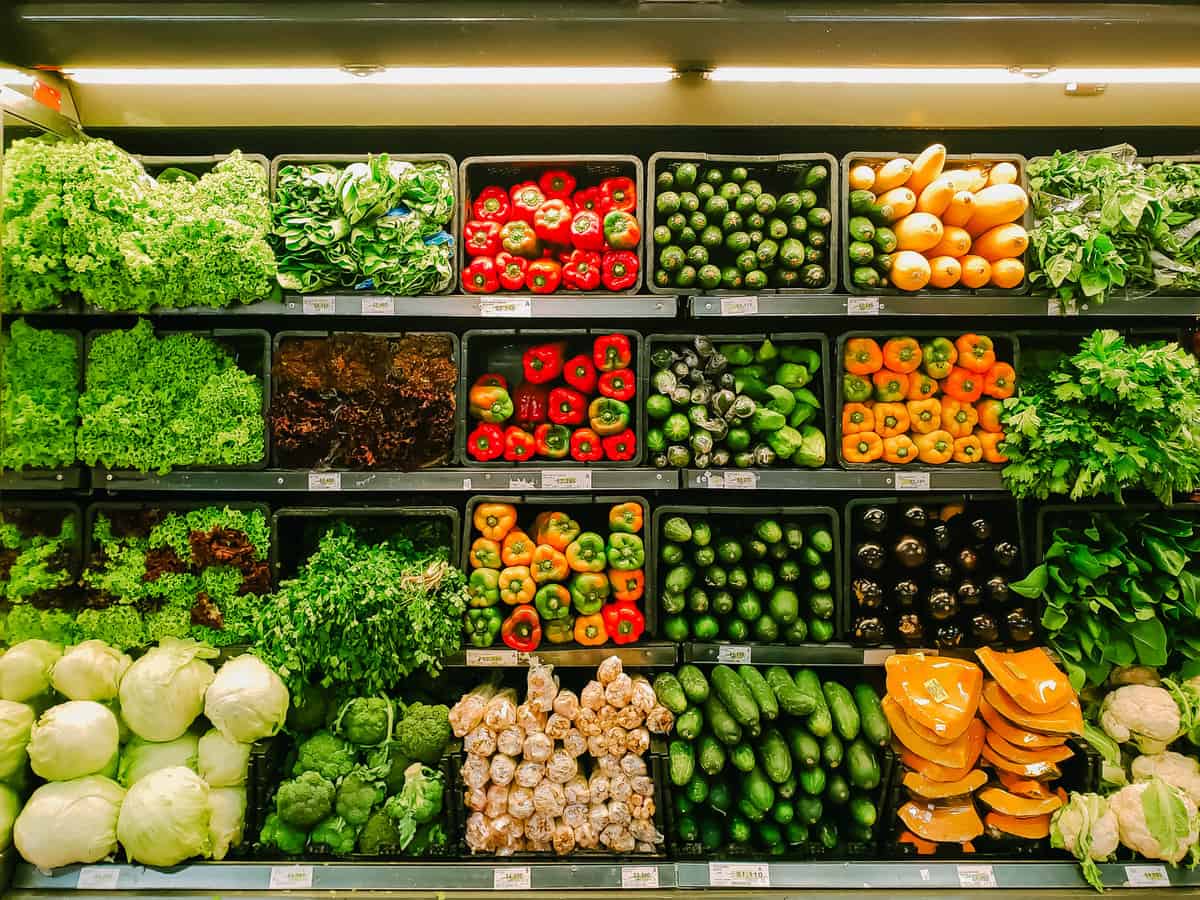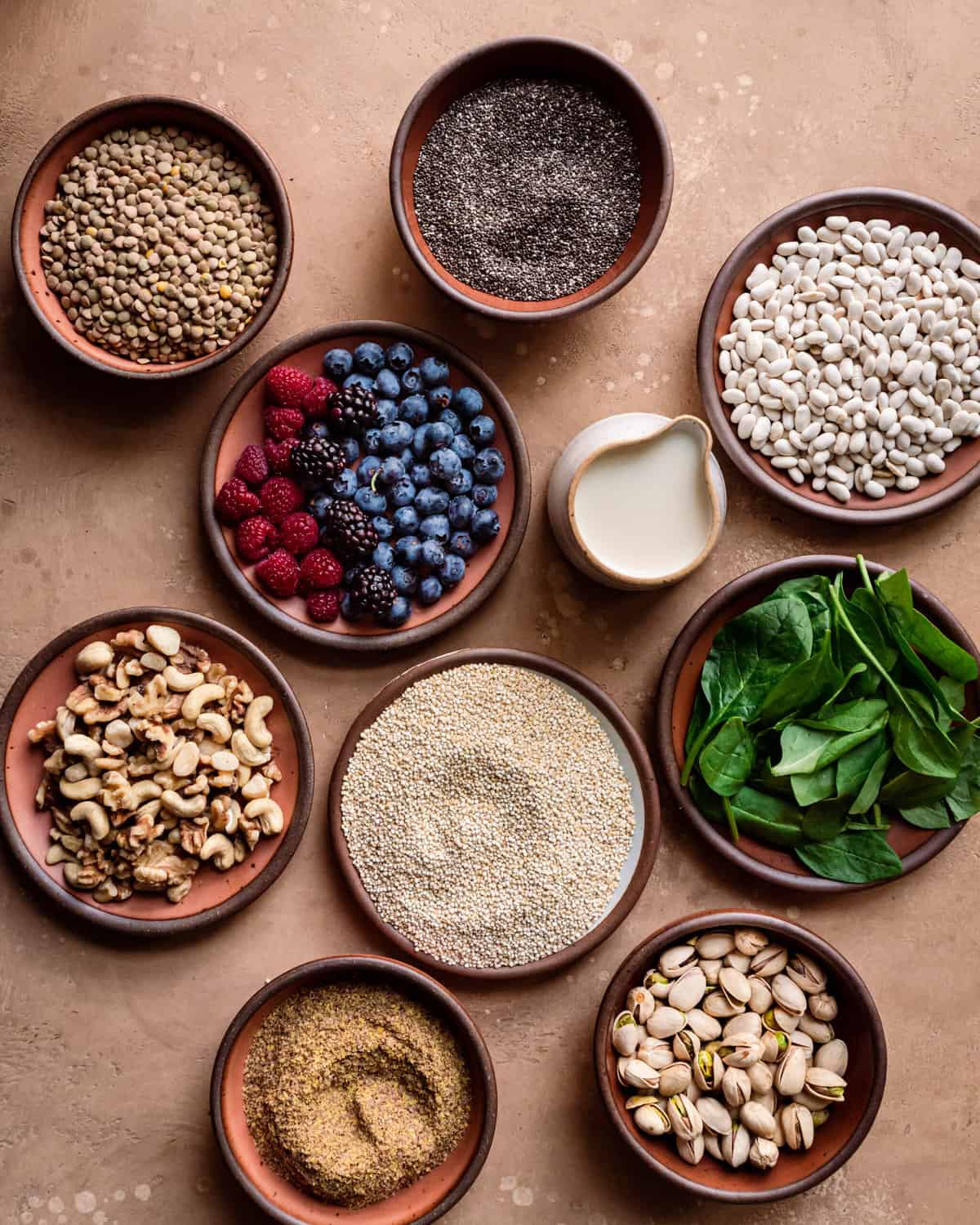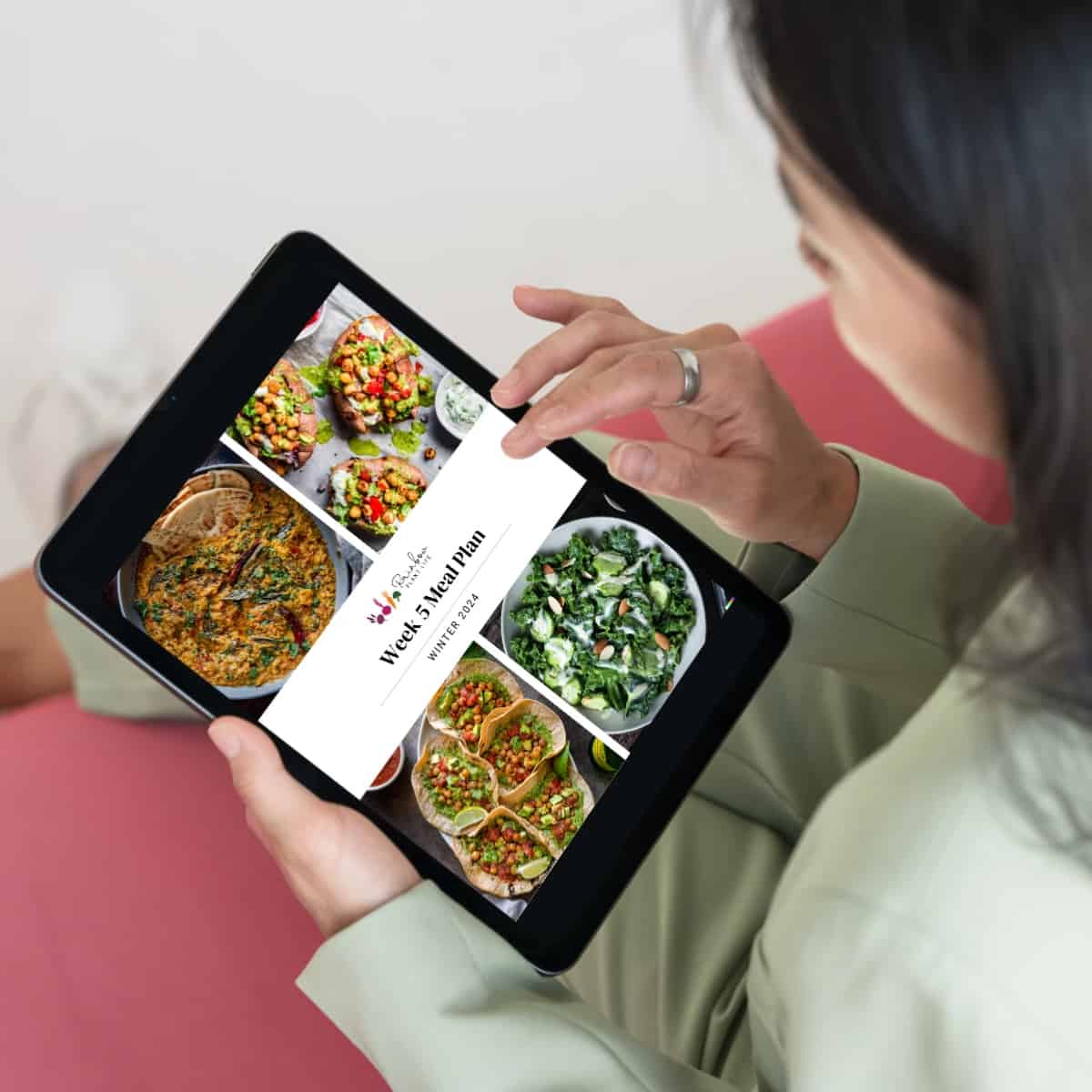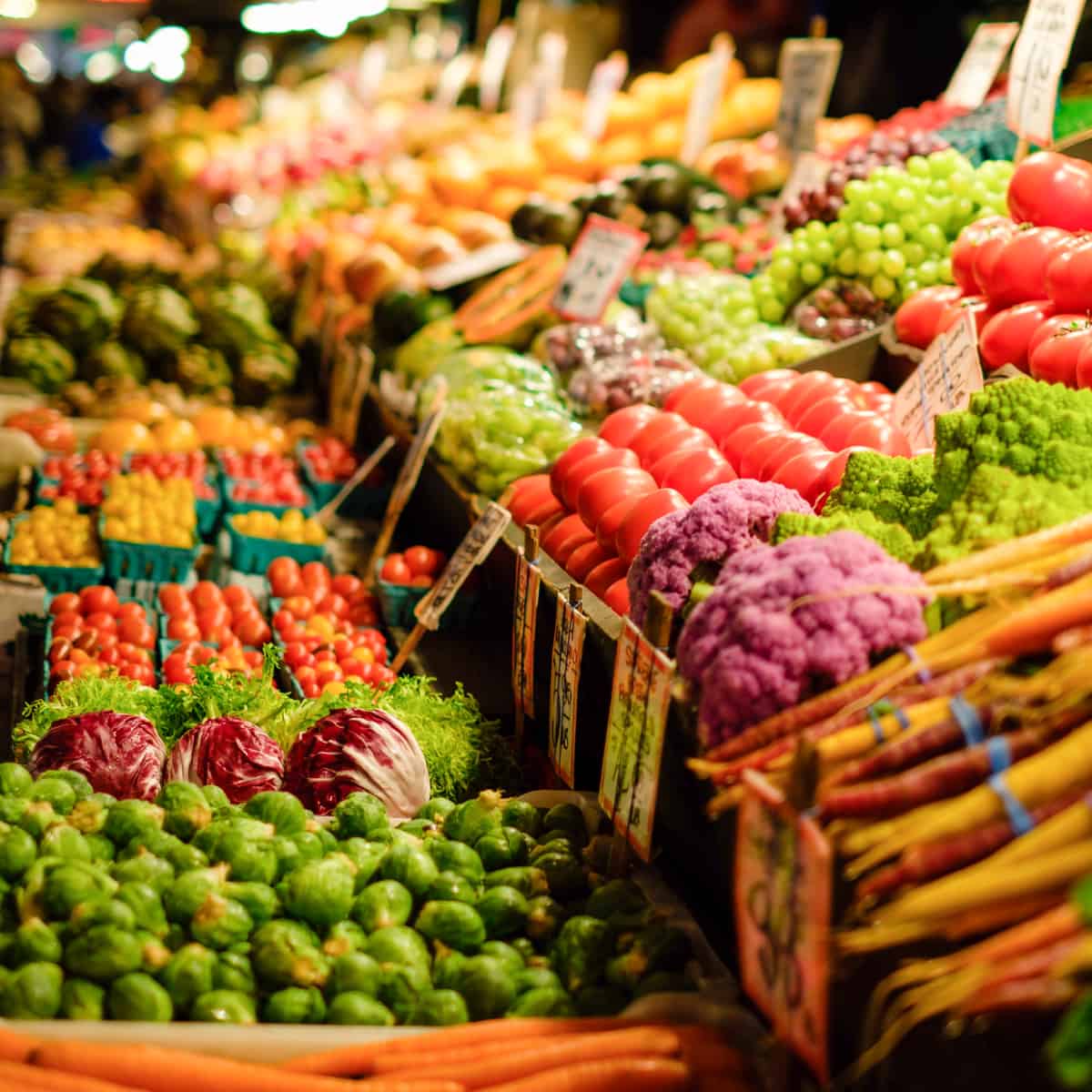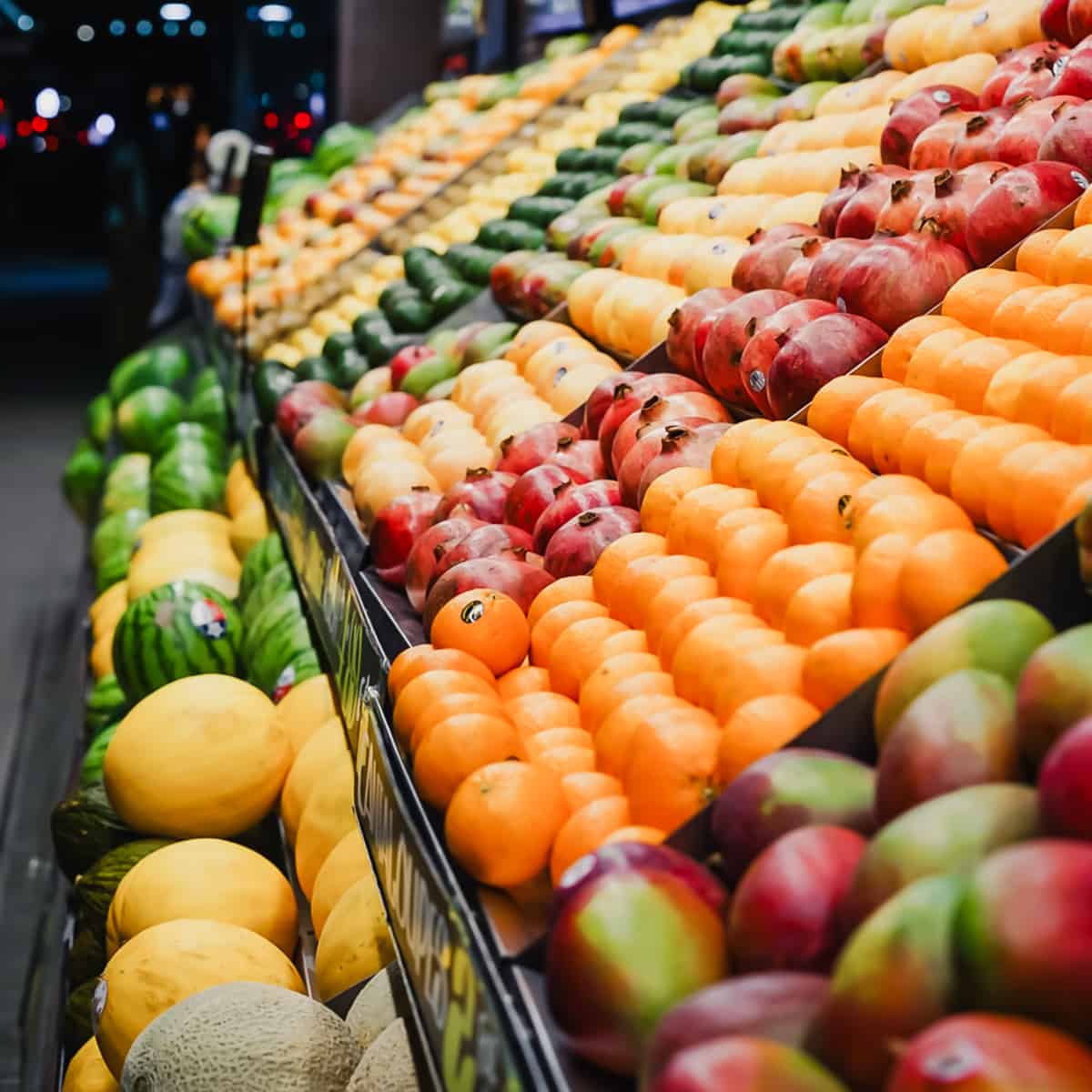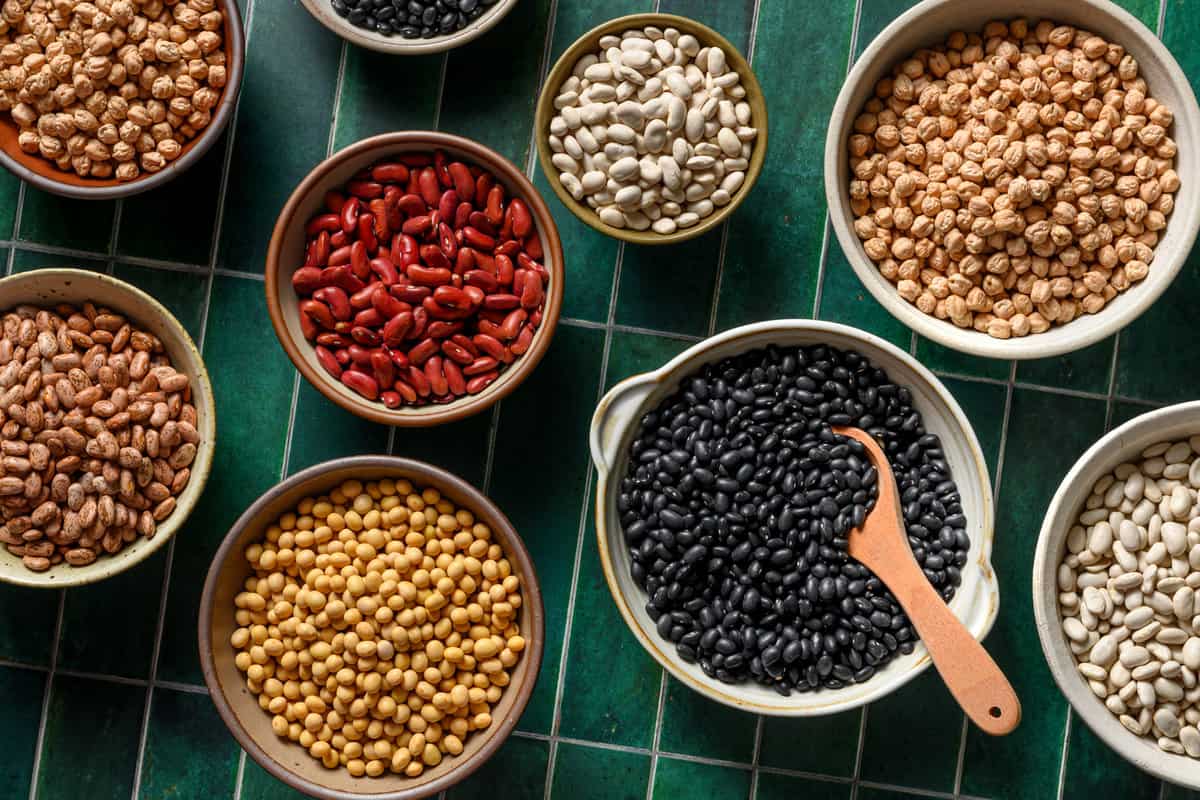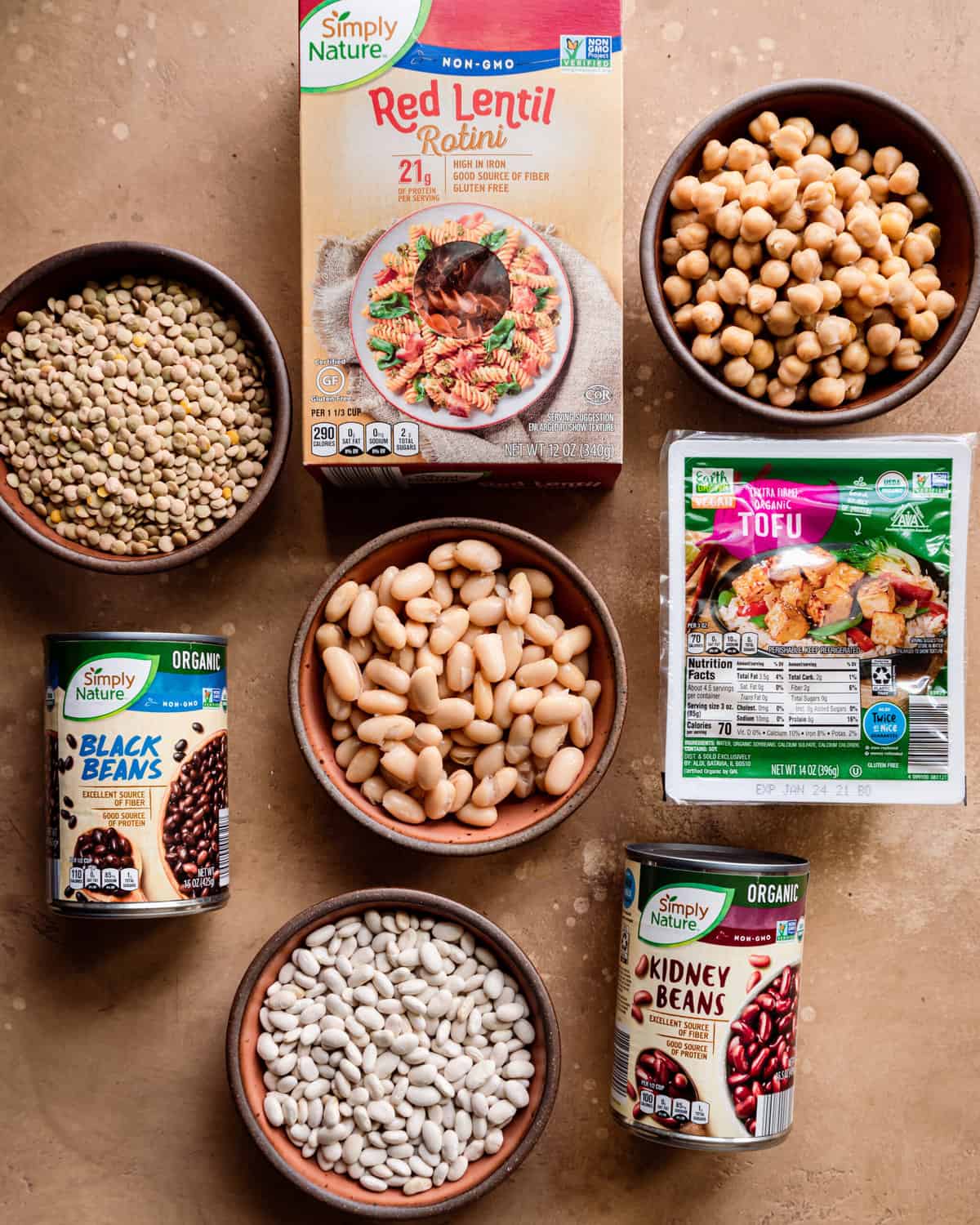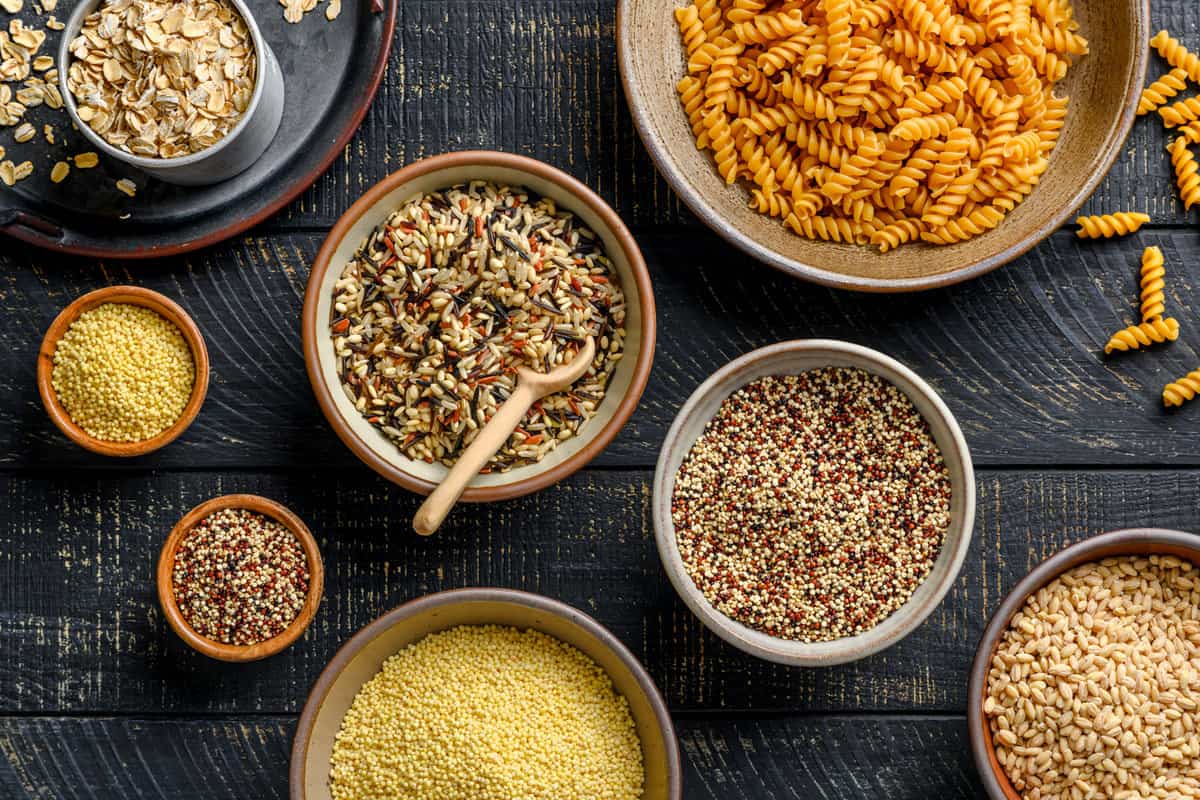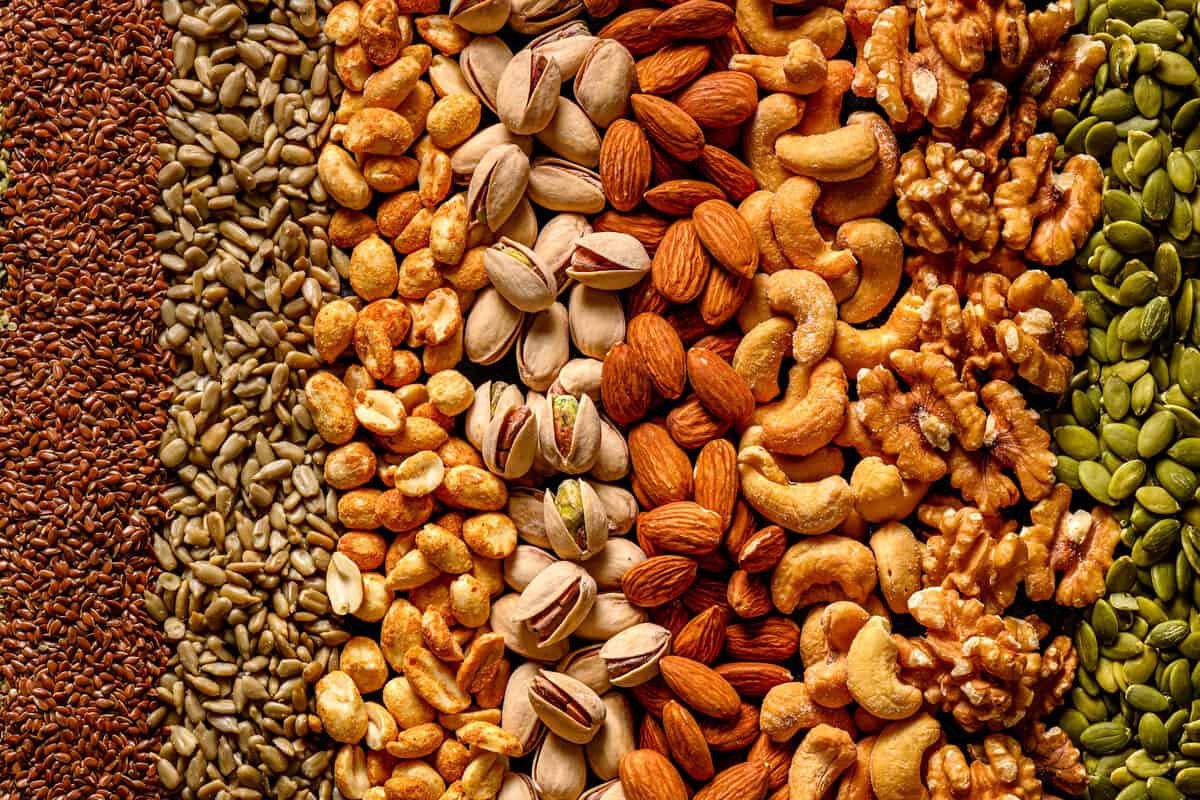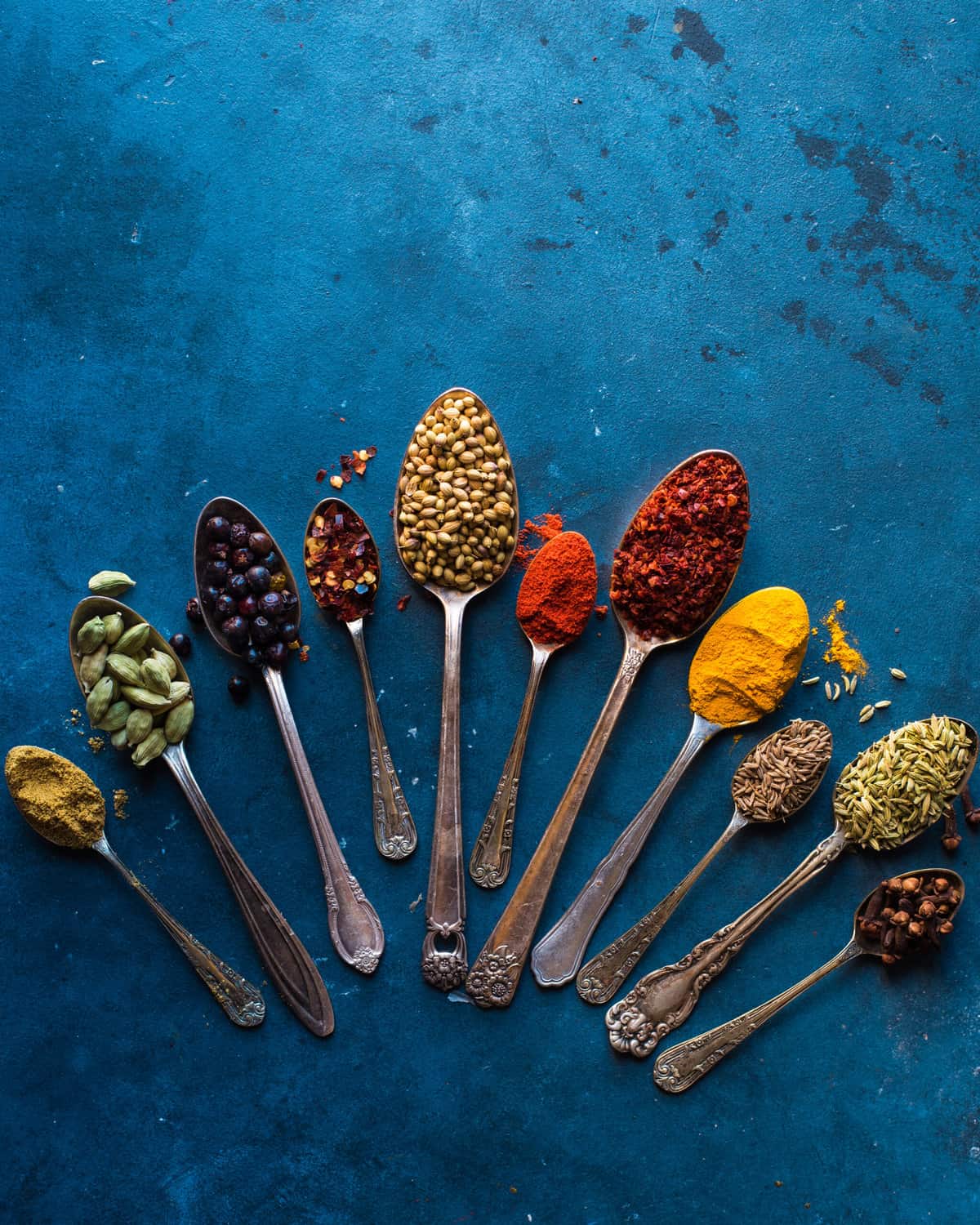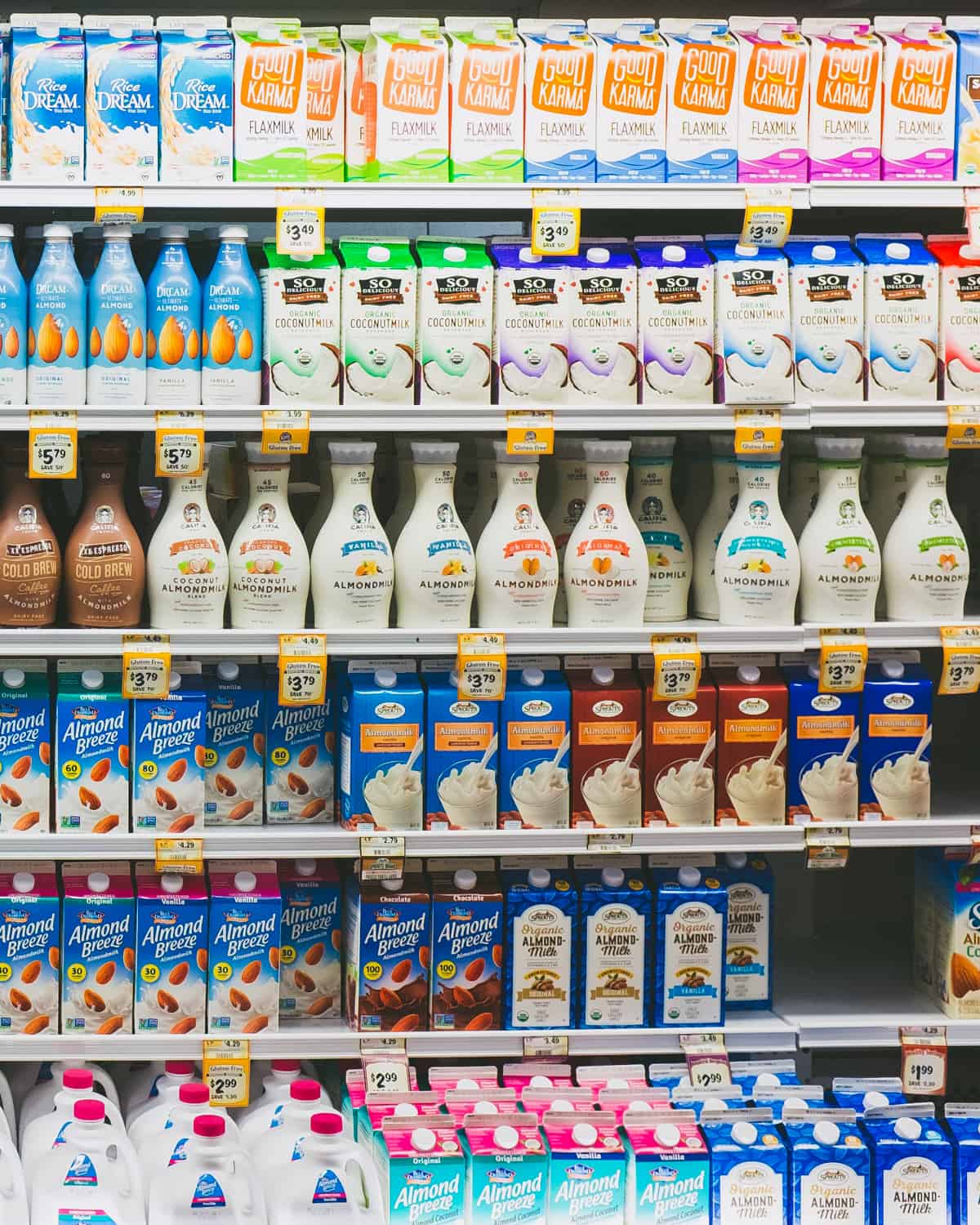To help you avoid eating veggie burgers and raw carrots for every meal, I’ve put together this comprehensive list of vegan grocery shopping tips and tricks. They’ll help you easily navigate the grocery store as a new vegan and how to spot all of the hidden vegan items as well as the newer, exciting products. You’ll also find an extensive vegan grocery list with both essential and fun items to help you create filling, flavorful, and budget-friendly vegan meals. Table of contents:1. Which grocery stores carry vegan products?2. Tips for vegan grocery shopping3. Vegan grocery shopping on a budget4. Vegan grocery list
Which grocery stores carry vegan products?
Every grocery store will carry on-purpose and accidentally vegan products, like produce, bread, condiments, spices, non-dairy milk, and pasta. Farmer’s markets are also a great place to find fresh, seasonal produce and specialty items. Most well-stocked major grocery stores, like Whole Foods, Trader Joe’s, Safeway/Vons, Wegmans, and Kroger, carry a wide selection of vegan products, including grocery list essentials as well as specialty vegan products, like egg replacements, ready-made meals, and vegan cheese. For the most exclusive products, head to your local natural food store.
Tips for vegan grocery shopping
Always read the labels
The FDA has made it law for food labels to identify if any major food allergens are used during production. These allergens include milk, shellfish, eggs, wheat, soy, tree nuts, and more. But what if there’s an ingredient you don’t recognize on the label? How are you supposed to know if it’s vegan or not? Thankfully, PETA has put together an extensive list of animal-derived ingredients to look out for on food and other product labels. Some of these ingredients, like bee pollen and cod liver oil, clearly sound like they come from animals. But others aren’t so obvious. The list below includes a handful of ingredients that may sound harmless but are actually NOT vegan-friendly:
Whey Casein Gelatin Bee pollen Lactose Lactic Acid Beeswax Rennet Isinglass Down Lard
Head to the vegan-friendly sections
You may feel overwhelmed and confused when walking into a grocery store as a vegan but you don’t have to! You can find vegan products in practically every section of major grocery stores nowadays:
Produce: Fruits and vegetables. Some vegan meat products and protein, like tofu and tempeh, can also be found in the fridges near the produce section, depending on the store. Dairy Alternatives: Dairy free alternatives, such as plant-based milk, yogurt, cream cheese, cheese, sour cream, mayo, whipped cream, and coffee creamer are usually sold in the dairy section, though some grocery stores have separate sections for plant-based alternatives. Bakery: Bread, bagels, tortillas, buns, pita bread, etc. Always be sure to read labels, as some bread products contain dairy products and/or eggs. When in doubt, freshly baked bakery-style breads like sourdough, French breads, and multigrain loaves are almost always vegan. Frozen: Ready-made meals, vegan ice cream, frozen fruits and vegetables, and some vegan meat products may be sold here. My personal go-to, frozen edamame, is also sold in this aisle. Meat Alternatives: Certain brands, like Beyond Meat and Impossible Food “meats,” may be placed in the same section as animal meat, though again some grocery stores have separate sections for plant-based meat alternatives. Pantry: So many items in these aisles! Think beans (both dried and canned), lentils, whole grains, pasta, condiments of all sorts, nuts, seeds, vegetable stock, spices, nut butters, cooking oils, baking ingredients, maple syrup, etc.
Look for new products
Once you get more comfortable with putting a vegan shopping list together, you can start trying new products. Check out this list of the 12 Best Vegan Products Coming in 2023 by VegNews and this PETA roundup of vegan food products coming in 2024. Pick a few items that look exciting and keep your eyes out on your next shopping trip! Splurging on new and exciting products every month makes the vegan shopping experience even more fun.
Vegan grocery shopping on a budget
Just because you’re vegan doesn’t mean you have to strain your wallet every time you go to the grocery store. I’ve mastered the art of cutting my grocery bill in half and even learned how to eat like a queen for just $5 a day! You can reduce your overall vegan grocery budget by following these tips and tricks:
Choose seasonal produce
There are endless benefits to eating seasonal produce; it’s better for the environment, our bodies, and our health. It’s also a budget-friendly way of eating! You save money by buying fruits and vegetables that are in season. This is because they’re in supply and don’t have to travel long distances to arrive at the grocery store. The best seasonal produce should be on display at your local grocery store and abundant at farmer’s markets.
Avoid pre-made foods
Skip the frozen dinners, pizzas, burritos, veggie burgers, or anything else that’s pre-made if you want to save money. These are typically more expensive than the ingredients you would buy to make a meal from scratch.
Buy in bulk
Buying food in bulk has long been a strategy of penny-pinching grocery shoppers for good reason! The upfront cost of food in bulk can look scary, but you’re ultimately spending less per item. Also, the large quantities mean the food typically lasts longer and keeps you from taking unplanned trips to the store. There are many plant-based foods available in bulk quantities, including nuts and seeds, beans, lentils, and grains. Some grocery stores even sell spices and dried herbs in bulk.
Dried vs. canned goods
When you want to save money, stick to dried food, like beans and legumes. Dried beans are cheaper because they aren’t cooked ahead of time or packed into heavy cans. The only downfall is they take longer to cook, but the results are much tastier than what you’d find in a can.
Have a meal plan
When you know what meals you want to make throughout the week, you avoid over-shopping and spontaneous, last-minute trips. Set aside one day per week to plan out and prepare breakfasts, lunches, dinners, and/or snacks for the week ahead. Check out my guide on How to Eat Well on a Budget + Weekly Meal Plan to learn more about designing a budget-friendly vegan meal plan. Does figuring out your own meal plan seem daunting? Then check out the brand new Meal Plans by Rainbow Plant Life! We take care of all the planning and guesswork out of weeknight meals for you. Each week, you get a PDF sent straight to your inbox that contains (1) a categorized grocery list complete with substitutions, (2) a quick but impactful set of meal prep steps that will streamlines your weeknight dinners, and (3) gourmet but doable recipes to whip up during the weeknight, stress-free.
Vegan grocery list
Let me start by saying you don’t need to add all of these items to your vegan shopping list. Pick and choose a few that you know you like and others that are new to you! It’s always a good idea to try new things to help you play in the kitchen and create more satiating and creative meals. Also, refer to your meal plan before you write your list and head to the store. This way, you only pick up the items you need for your planned recipes and avoid overspending. I have plenty of vegan recipes to choose from, most of which are perfect for prepping for the week ahead! And if endless choice feels overwhelming and you’d prefer someone to do the hard work of selecting what to cook each week, check out our brand new weekly meal plan service!
Vegetables
Fresh and frozen vegetables should make an appearance on every vegan’s grocery list. They’re the backbone of most of our meals and, of course, a wonderful source of vitamins and minerals.
Garlic Ginger Onion Shallots Potatoes Sweet potatoes Winter squash (and summer squash) Tomatoes Cucumbers Broccoli Cauliflower Brussels sprouts Cabbage Green beans Asparagus Mushrooms Leafy greens (romaine, kale, spinach, etc.) Corn Peas Bell peppers Fresh herbs (cilantro, parsley, dill, etc.) Scallions
Tip: Research which veggies are in season before you go shopping (this long list from the USDA is a great place to start; you can also get more regional-specific using the website Seasonal Food Guide). Choosing seasonal vegetables will help you get the best produce possible so you can put fresher meals on the table.
Fruits
Both fresh, frozen, and dried fruits can be found at most grocery stores and come with endless uses. You can eat it as a snack, blend it into a fruit smoothie, bake it into a crisp for a crowd-pleasing dessert, fold dried fruit into cookie dough, and so much more.
Lemons Limes Apples Avocados Pears Peaches Strawberries Raspberries Blueberries Cranberries Nectarines Oranges Plums Medjool dates Cherries Grapes Bananas
Tip: Just like vegetables, choose seasonal fruit as much as you can. This list from the Food Network shares which fruit is in season and when.
Proteins
Protein is an important part of any diet, vegan or not. And finding vegan-friendly protein isn’t as hard as you may think! These are my favorite items to use when I want to create a filling and satisfying meal:
Beans
Most kinds of beans are loaded with protein and are very flexible, so you can use them to bulk up all kinds of vegan meals.
Black beans Chickpeas Cannellini beans (white kidney beans) Navy beans Pinto beans Kidney beans Black-eyed peas Adzuki beans Lima beans
Choose from any of these 40 Fantastic Bean Recipes as an introduction to cooking with beans. I’m my Creamy White Bean Soup with Kale’s number 1 fan because it’s so flavorful and you hardly notice the beans. Or, for a more bean-forward dish, try these Mexican Black Beans! Tip: Dried beans are budget-friendly and will last a very long time, but canned beans are ready to use at a moment’s notice. Check out my guide on How to Cook Beans in the Instant Pot if you’re new to cooking with dried beans.
Lentils
Lentils are my favorite legume. Not only are they jam-packed with plant-based protein, but they’re also incredibly versatile! You can use lentils as a source of protein in stews, salads, soups, curries, and so much more.
Red lentils Yellow split lentils Green lentils Brown lentils French lentils (puy lentils) Black beluga lentils
Tip: Red lentils and yellow split lentils are the easiest varieties to cook, especially for beginners. If you have an Instant Pot, cooking lentils in the Instant Pot is a great hands-free method option.
Soy products
Don’t listen to the myths about soy being bad for you – it’s not! Soy is a magical ingredient that has some of the highest amounts of plant-based protein and may even reduce your risk of cancer.
Edamame Tofu Tempeh Miso Soy sauce and/or tamari
Note: Tofu may be one of my favorite soy products because it’s so incredibly versatile. You can use it to make Tofu Scramble, Tofu Stir Fry, copycat Chipotle Sofritas, and so much more! To really master tofu, check out my Complete Guide to Cooking Tofu! And while tempeh may not be as popular, it’s incredibly nutritious (18g protein & 6g fiber in just 3 ounces!). Learn how to make it taste great in my Complete Guide to Cooking Tempeh.
Nuts and seeds
Nuts and seeds are handy to have in your pantry because they can be used to make crispy condiments, homemade nut milk and nut butter, and even vegan cheese, like this versatile Vegan Queso.
Cashews Almonds Walnuts Pine nuts Peanuts Pistachios Sunflower seeds Sesame seeds Pepitas (shelled pumpkin seeds) Hemp seeds Flax seeds Chia seeds
Grains and bread
Whole grains are pretty much always vegan, and it’s quite easy to find vegan-friendly pasta and bread in all major grocery stores. You just have to know what to look for:
Whole grains
Whole grains are a wonderful source of fiber, iron, B vitamins, and more health benefits. They also come with a long shelf-life and many uses! When cooked, whole grains can easily bulk up a vegan curry or chili and even make for a filling breakfast.
Brown rice Farro Quinoa Wild rice Millet Barley Rolled oats (or steel-cut oats) Bulgur
Pasta
While fresh pasta is traditionally made with eggs, most types of dry pasta sold in grocery stores is vegan.
Long-, short-, and medium-grain pastas (most are vegan, but check labels to avoid egg) Gnocchi (check labels to avoid egg and dairy products) Orzo Alternative pastas such as brown rice pasta, lentil pasta, and chickpea pasta
Bread
Bread made without dairy, honey, or eggs is easy to find in most grocery stores. Just look in the bakery section!
Bakery-style loaves and baguettes (varieties like sourdough, French breads, and multigrain loaves are almost always vegan) Sandwich bread (read labels to avoid egg whites, milk, honey, etc.) Bagels (most are vegan, but check labels or ask your local bakery; avoid bagels with cheese or honey) Flatbread (look for options without milk or yogurt) Pita bread (look for options without milk or yogurt) Naan (look for “vegan naan”)
Condiments and seasonings
You can’t have a spice rack without dried spices and you can’t have a pantry without a wide variety of condiments. These simple sauces, oils, spices, and herbs not only have a long shelf-life but also add excitement and flavor to your meals!
Cooking fats
Extra virgin olive oil Neutral-flavored oils (e.g., avocado oil, canola oil) Refined coconut oil Toasted sesame oil Vegan butter
Condiments and Seasonings
Tahini (sesame seed paste) Nut butters (e.g., peanut butter, almond butter, cashew butter) Mustard (regular yellow, Dijon, spicy, whole grain) Soy sauce and/or tamari Vinegar (red wine, champagne, white wine, balsamic, distilled white, apple cider, rice, etc.) Hot sauce (most are vegan, just read labels to confirm) Cornstarch, potato starch, and/or arrowroot powder Nutritional yeast Vegetable broth (low-sodium and regular) Panko breadcrumbs (read labels, as some brands contain milk) Tomato paste Canned tomatoes Barbecue sauce (almost always vegan; sticking with organic varieties will ensure this, as organic sugar is always vegan) Ketchup (almost always vegan; sticking with organic varieties will ensure this, as organic sugar is always vegan)
Spices
Kosher salt Sea salt Flaky sea salt Freshly cracked black pepper Ground cinnamon Ground turmeric Ground cumin Ground coriander Garlic powder Onion powder Sweet or hot paprika Smoked paprika Chili powder Bay leaves Dried herbs (e.g., oregano, thyme, mint)
Dairy substitutes
Vegan dairy substitutes are more abundant than ever these days. You can find the listed products and more in the dairy section or natural food section of the grocery store.
Plant-based milks (oat, soy, cashew, coconut, almond, etc.) Canned coconut milk and canned coconut cream Plant-based yogurts (coconut, oat, soy, almond, etc.) Vegan cheese (shredded and blocks, feta, parmesan, cream cheese, etc.) Vegan butter (most grocery stores sell them in sticks these days, which is my preference over tubs) Vegan sour cream Vegan whipped cream
Not sure where to start with vegan cheese? Check out The Complete Guide to Vegan Cheese.
Baking and sweets
Whipping up vegan baked goods is just as fun as traditional baking, but they skip the eggs and dairy for vegan-friendly egg replacements and dairy free milk and cream. All you need are a few staple ingredients in your pantry.
Flour (all-purpose, whole wheat, spelt, whole wheat pastry, etc.) Alternative flours (e.g., oat, almond) Baking soda Baking powder Maple syrup Agave nectar Organic cane sugar (buy organic, as conventional granulated sugar is refined through animal products) Organic brown sugar Coconut sugar Cocoa powder Dark chocolate (read labels to ensure there’s no milk added) Vegan chocolate chips Pure vanilla extract
If these vegan grocery shopping tips helped you put a shopping list together and made you more confident walking into the store, let me know in the comments below!
